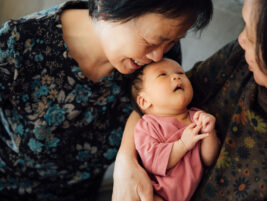Introduction
A major challenge that human beings face across the lifespan is to reach homeostasis between physical and emotional states in response to a myriad of difficult situations .. Homeostasis, or balance, requires achieving affect regulation. Affect regulation (AR) has been defined as the capacity to control and modulate emotional responses (Fonagy et al., 2002). Infants cannot do this alone. Rather, they are motivated to regulate their emotions within the context of interaction and relationship with a caring adult, most often their parents. They communicate with and co-create intersubjective states with their caretakers (Tronick, 1989). Dyadic regulation (DR) implies that affective regulation is supported by both the adult and infant and enables the child to progressively modulate increasingly complex states of mind, scaffolding in this way the achievement of affective self-regulation. Parents, as auxiliary adults, provide “hidden regulators” (Hofer, 1995) of infant states of consciousness and work as agents of affect transformation, repairing negative affects and collaborating to support the infant’s regulation. Therefore, the infant’s affective organization simultaneously depends on his/ her own regulatory capacity and the regulatory scaffolding provided by the caring environment (Tronick, 1989). Hence, if dyadic regulation successfully occurs, the infant may achieve the capacity to control and modulate his/her own negative emotions, building his/her own capacity for affective self regulation
While achievement of dyadic affect regulation and the transition to affect self- regulation have a positive impact on healthy development, frequent affective misregulation and negative affects may produce developmental drawbacks and defensive closure. Tronick (2005) suggests that infants require energy in the form of meaningful communication about the world to coherently organize their states of consciousness and that another human being is the privileged partner to continuously co-create new meanings. Two minds can reciprocally generate, communicate and integrate meaning increasing coherence and driving development. In this co-creation of complexity and meaning, the dyadic primary bond is essential. Parental disposition to carry out the nurturing function is crucial for development. In this line, we are studying how parental reflective capacity can contribute to the making meaning process and how this can relate to the infant’s ability to symbolize and engage in symbolic play.
Parental Reflective Function (PRF), as closely related to the concept of reflective functioning (Fonagy & Target, 1998), is a specific feature of mental functioning considered as an essential aspect of the way parents can understand and signify their child’s behaviors (Slade et al., 2004). PRF refers to the parent’s capacity to recognize that the infant or toddler has mental states, feelings, thoughts, and intentions of his own and is related to the parent’s sensitivity to understand that both their child’s and their own behavior and emotional displays are connected in meaningful ways.
Slade (2004) suggests that a mother’s capacity to hold in her own mind the notion of having feelings, desires, and intentions allows the child to discover his own internal experience via his mother’s experience. Thus maternal reflective functioning constitutes a relevant contribution to the child’s capacity to regulate his own affective displays and reparation of affective disruption.
Dyadic making meaning process and affective regulation have a central role in building the infant’s capacity to organize. Different contexts of dyadic play can provide a privileged position for the observation of such a process. The experience of playing in the first years of life facilitates the emergence of the self and subjectivity, and provides a sense of trust in oneself and in the other. The mother-infant free play expands interactional opportunities and presents a complex pattern of dyadic affective matches and mismatches (Tronick, 1989). Through play the child not only achieves self-affirmation, a sense of agency and develops self-representations, but also experiments with feelings of joy and pleasure, allowing an expansion of his/ her exploratory actions (Dio Bleichmar, 2005). Moreover, through dyadic play both child and adult live real mental experiences. This scenario takes place throughout infancy and childhood. As Keren and colleagues, point out (Keren et al., 2005), symbolic play is a process that unfolds in time with clear sequential relations between the parent’s facilitation of child symbolization and the complexity of the child’s symbolic expression. Within the particular modality of “pretense” the child can perceive how the adult reflects about mental states. This mentalizing attitude of the parent provides the child with a representation about contents of both his and his parent’s mind (Fonagy & Target, 1998). During play, the adult can offer the child a link between reality and “as if” – ideas and feelings, showing that they can share an experience that “suspends” their asymmetrical situation in the real world (Sroufe, 1996, 2002).
In previous studies (Schejtman et al., 2006; Huerin et al., 2006; Duhalde et al., 2010), we have described some specific features of the building of the capacity to being alone in the presence of other (Winnicott, 1971) and their link to the achievement of affective self-regulation and the way in which mothers are a part of this process, conforming a playing zone both for the infant and the mother. Microanalysis of videotaped mother-infant play interactions and analysis of interviews with mothers allowed us to suggest inferences about the way in which child’s play and dyadic play relate to both dyadic and self affective regulation. Likewise, follow up of the same sample, studying a group of children that reached preschool years, gives the opportunity to examine the relationship between affective regulation and symbolization in the light of maternal reflective functioning at different ages.
In this paper, we present new findings from our ongoing longitudinal research on the relationship between Maternal Reflective Function, Dyadic Affective Regulation (DAR) and children’s Affective Self Regulation (ASR) in the first 5 years of life, and their link to the development of symbolic play. In this presentation, emphasis will be on the relationship between maternal reflective functioning and dyadic play at two different ages of the children: 6 months and 30-40 months old.
Method
Sample and procedures
The sample of this study included 48 mothers, between 19 and 39 years old, with their healthy babies, 23 to 31 weeks of age, 50% boys, 50% girls. The inclusion criteria for mothers were the completion of a high-school education and medical check-ups at least twice during pregnancy. The exclusion criteria were maternal disease or illness, pregnancy, birth and puerperal complications and infant’s disease or illness.
Mothers were recruited through the infants’ pediatricians, who invited them to participate in a study of normal child development. Once a mother accepted the invitation, a senior psychotherapist of our team called her to make an appointment to see her with her infant at our lab. In total, 21 mothers of the original sample were enrolled and went through the interview, but only 17 agreed to be videotaped with their 30-40 months old infants.
Procedures: Mother-infant (6 months) play interactions were videotaped in two interactive situations: 3-minute Face to Face (FF) interaction situation, 5-minute Free Play (FP) interaction with toys.
When infants were between 30 and 40 months old, mothers were interviewed using the PDRII (Slade et al., 2005), a 90 minutes semi-structured interview aimed at assessing Maternal Reflective Function. In addition, mother-infant dyads were videotaped in a 15-minute free play interaction situation with a set of toys (Keren et al., 2005).
Measures
Maternal Reflective Function (MRF) was assessed through the analysis of the transcriptions of the Parental Development Interview PDI-RII (Slade et al., 2005). The analysis of the interviews was conducted under the supervision of Prof. Arietta Slade by two certified coders, A. Zucchi and V. Huerin. Maternal reflective functioning was scored as Negative, Lacking, Questionable or Low, Ordinary, Marked, Exceptional.
Measures at 6 months
In order to analyze dyadic affective regulation at 6 months the 3 minute face to face (FF) mother-infant interaction was micro-analyzed second by second using the Infant and Caregiver Engagement Phases Scoring System (ICEP) (Tronick & Weinberg, 2000); interrater reliability was 79.4% (percentage agreement) and 0.64 (Cohen’s Kappa). Also, the 5 minutes Free Play (FP) mother-infant interaction was analyzed every 5 seconds, using the Free Play Scale (Tronick, 2003), an adaptation of the ICEP Scale. Interrater reliability was 84.3% (percentage agreement) and 0.55 (Cohen’s Kappa).
Dyadic Affective Regulation measured variables (both in FF and in FP situations): Mother expressivity (positive, neutral or negative affect), Infant expressivity (positive, neutral and negative affect) and dyadic matches and mismatches (Match: mother and infant are in the same engagement phase and share the same affect expression).
Measures at 30-40 months
The 15-minute, videotaped sequences of mother-child play when the children were 30-40 months were segmented into 45 fragments of 20 seconds and codified through the Interactive Play Scale (Duhalde et al., 2010). This coding system considers three aspects of mother-child play. 1) Mode of mother/child interaction, including the following dyadic categories: Convergence (mother and child are engaged in the same play agenda, they share affects related with play situation), Divergence (mother and child find it difficult to share a playing agenda), Non-interactive play (mother and child display a parallel play situation). 2) Affective misregulation signs (impulsivity/aggression, cry/complain and inhibition/ withdraw). 3) Child’s level of symbolization during play, including the following categories: Functional play (no pretend mode, when play and use of objects during play do not transcend their conventional functions), Basic symbolic play (just pretend mode), Complex symbolic play (pretend mode characterized by role attribution or by substitutive use of the object). Interrater reliability for these variables was Cohen’s Kappa= 0.94.
Results
Maternal Reflective Functioning (MRF) distribution: 9 mothers (37.5%) presented Questionable-low MRF, 11 mothers (45.8%) presented 5 Ordinary MRF, 4 mothers (16.7%) presented 7 Marked MRF. No mother presented MRF under 3 or over 7.
Dyadic affect regulation at 6 months. As seen in table 1, in the Free Play (FP) situation at 6 months mothers spent 83.1% of the valid coded time displaying positive affect, 16.91% displaying neutral affect, and 0 % negative affect. These proportions are very similar to those displayed in the Face to Face (FF) situation where they spent 86% of the time in positive affect, 14% in neutral affect and 0% in negative affect. Likewise, infants presented a similar distribution of affect in both studied situations. In FP situation they spent 12.1% of the valid coded time in positive affect, 86.6% in neutral affect and 1.3% in negative affect. In FF situation infants spent 16% of the valid coded time in positive affect, 82% in neutral affect and 3% in negative affect., In both situations we found that dyads spent most of the time (66% In FF, 71.6 % in FP ) spending the rest of the valid coded time in mismatched states, where the most common mismatch was the mother displaying positive affect and the infant displaying neutral affect.

Patterns of mother-child interaction at 30-40 months. When children were 30/40 months old, mother and child spent 61% of the valid coded time in play Convergence, sharing a playing agenda, while 11.7% of the valid coded time they were in Divergence and the remaining 27.3% of the time they displayed a Non-interactive play (parallel play, 9%; only child playing, 16.3%; or only mother playing, 2% of the total valid coded time).
Affective Misregulation. 8 of the 17 (47%) mother-child dyads at 30-40 months presented at least one misregulation sign such as impulsivity/aggression or inhibition/withdraw. We found no misregulation signs in the remaining 9 dyads.
Child’s level of Symbolization during play. Children were engaged in symbolic play (either basic or complex one) 69.2% of the time (30.2% of the total time they displayed basic symbolic play and 39% of the total time they displayed complex symbolic play. The remaining 30.8% of the valid coded time was divided between functional play (24.3%) and no play (6.5%).
Links between Maternal Reflective Functioning and Affective Regulation at 6 months. While no relationship was found between MRF and mother-infant affective display in the face to face situation at six months, it was found that in the free play situation, mothers with ordinary or marked MRF were less positive and more neutral than mothers with low MRF (Positive Affect 75.2% vs. 92.8%; Neutral Affect 24.8% vs. 7.2%) (K&W test: p< 0.05). Moreover, dyads whose mothers reached an ordinary or high MRF (n=14) presented more positive matches (14.7%) –mother and infant expressing positive affect in the same segment of time- than dyads whose mothers reached a low MRF (n=7): 8.9%.
Links between Maternal Reflective Functioning and Affective Regulation at 30-40 months. A meaningful relationship between MRF and mother-child mode of interaction was found at 30-40 months. Parallel play was higher (10% vs. 5%) in mothers with low MRF (p=>0.05 Mdn Test) and a tendency shows that Divergent Interactive Mode is also higher among Low MRF mothers (14% vs. 9%) (p=>0.1 Mdn Test). Also interesting, regarding children’s affective misregulation signs, we found that while in the case of mothers with low MRF 4 over 6 (67%) children presented at least one misregulation sign. In the case of mothers with ordinary or high MRF, only 2 of the 11 children (18%) present ed any misregulation sign.
Relationship between Affective Dyadic Regulation at 6 and 30-40 months. We explored the existence of a longitudinal correlation between dyadic regulation variables at 6 months (matches and mismatches) and mother-child modes of interaction during play at 30/40 months (Convergence-Divergence). Results showed no direct relationships between the mentioned variables.
Discussion
Results showed that at 6 months of age, the infants and their mothers are in a dyadic positive matching state around 16% of the coded time. This finding was similar in the Face to Face (FF) and in the Free Play (FP) situation and is similar to Tronick’s work on mismatch as a normative feature of mother-infant interaction, suggesting that a healthy interaction is messy and more based on reparation of mismatches, rather than an idealized matched and synchronous interaction (Tronick, 2005).
Regarding Maternal Reflective Function (MRF), No relationship was found between MRF and mother-infant affective display in the face to face situation at six months. In the Free play situation, mothers with ordinary or high MRF were less positive and more neutral towards their infants than mothers with low MRF and at the same time these dyads showed more matches than dyads with low MRF mothers. Thus, it might be inferred that reflective mothers are more capable of modulating their own affect or emotions in face of their infant’s neutral or positive affect, and are more attuned to the infants’ affective neutral display and initiatives, encouraging distal exploration with toys. When a sensitive and high reflective mother offers objects, expansion of the interaction and communication takes place, adding complexity. We can also add that the FP situation, as more expanded than FF, enables a higher possibility to study the presence of more complex interactive and subjective variables.
Even though we didn’t find a direct relationship between MRF and frequency or complexity in children’s symbolic play, some findings require our attention. Taking into account, of course, the differences regarding quality and complexity between both situations, at 30/40 months, we reported (Duhalde et al., 2010) that the presence of misregulation signs was more frequent in dyads mostly engaged in functional play while dyads without misregulation signs display more complex symbolic play. This finding is linked to the finding that in low reflective mothers dyads there were more misregulation signs. A higher divergent mode of interaction enables us to create an indirect link between maternal reflective functioning and level of symbolization in the dyadic play.
A recent study of ours (Duhalde et al., 2010) showed that when children are 30-40 months old there is a positive relationship between convergent interactive mode –mother and child acting together- and the level of the symbolic play as reflected in the children’s play. On the other hand, the higher amount of divergent interactive mode and more frequency of misregulation signs were related to a lower level of symbolization in the child’s play.
Even if MRF did not show a direct or global link to the child’s level of symbolization during play, an interesting finding that should be further explored showed a higher presence of affective misregulation signs and higher divergent mode of interaction in dyads whose mothers show low MRF. The child’s affective misregulation signs involve rejecting expressions, complaints, and impulsivity that are frequently disrupting the playing scene and consequently not facilitating symbolization.
It seems that when adults are less reflective, they can probably be less empathic or somewhat intrusive and misregulation may bring disruptions that hinder the construction of greater symbolic complexity in the playing scene. From a qualitative analysis point of view, these interruptions can be connected with the emergence of anguish or distress that cannot be solved within the playing scene itself.
In this study we have not found a direct link between dyadic matches and mismatches at 6 months and convergence and divergence at symbolic play at 30-40 months. Play at 30-40 months presents higher complexity and the assessed convergence-divergence is then a more complex and subtle construct than the matches-mismatches assessment conducted in the 6 months study. On one hand this result might be due to the small number of dyads that took part in the second stage of the research. But also, although we are aware of the crucial importance of the first year of life as related to the constitution of psychic structure, it might be thought that not everything is defined during the first months of life due, among other factors, to the capacity and possibilities of recurrent reparation of mismatches and the achievement of a more attuned bond with the mutual experiences and this particularly in a sample composed by a low risk population like the one presented here.
Conclusions
Maternal Reflective Functioning is a theoretical construct that refers to a complex aspect of psychic functioning and the found results should be considered under the light of such complexity. We need to deepen our comprehension about the subtle mechanisms through which the differences in MRF are expressed.
According to these results, we also plan to deepen the study of maternal variables. We are now studying the incidence and contribution of specific maternal styles of interaction during play, namely restrictive or facilitating maternal style (Keren et al., 2005), and studying their link to reflective functioning.
Taking into account the fact that our findings relate to a normative, low risk, non clinical sample, this study suggests that even normal development is complex. Dyadic and maternal variables are related in different ways that may facilitate or interrupt symbolic enrichment in infancy and early childhood. The next step is to compare our healthy sample to a high risk one.
References
Dio Bleichmar, E. (2005). Manual de psicoterapia de la relación padres e hijos. Buenos Aires: Paidós.
Duhalde, C., Tkach, C., Esteve, M., Huerin, V. & Schejtman, C. (2010). “El jugar en la relación madre-hijo y los procesos de simbolización en la infancia” (“Playing within mother-infant relationship and symbolisation processes in childhood”). In Anuario de Invastigaciones XVIII, Facultad de Psicología, UBA.
Fonagy, P. & Target M. (1998). Mentalization and the changing aims of child psychoanalysis. Psychoanalytic Dialogues, Vol. 8, 87-114.
Fonagy, P., Gergely, G., Jurist, E. & Target, M. (2002). Affect Regulation, Mentalization: Developmental, Clinical and Theoretical Perspectives. New York: Other Press.
Hofer, M.A. (1995). Hidden regulators: implications for a new understanding of attachment, separation and loss. In Goldberg, Muir & Kerr (eds.). Attachment Theory: Social Development and clinical perspectives. Hillsdale, NJ: The Analytic Press, Inc.
Huerin, V., Zucchi, A., Duhalde, C. & Mrahad, C. (2006). Funcionamiento reflexivo materno y regulación afectiva en la relación madre-hijo. En Memorias de las XIII Jornadas de investigación. Paradigmas, Métodos y Técnicas, Tomo III, pp. 215-217, Facultad de Psicología, UBA.
Keren, M., Feldman, R., Namdari-Weinbaum, I., Spitzer, S. & Tyano, S. (2005). Relations between parents´ interactive style in dyadic a triadic play and toddler’s symbolic capacity. Am J Orthopsychiatry, 75 (4):599-607 16262517 (P, S, E, B).
Schejtman, C., Vernengo, M.P., Vardy, I., Silver, R., Mindez, S., Mrahad, M.C., Feldberg, L., Leonardelli, E., Lapidus, A., Umansky, E. & Barreyro, J.P. (2006). “Regulación Afectiva Madre – Infante, su relación con la Autoestima y el Funcionamiento Reflexivo de las madres como moderadores del impacto emocional de los sucesos de vida”. En Memorias de las XIII Jornadas de investigación. Paradigmas, Métodos y Técnicas, Tomo III, pp. 267-269, Facultad de Psicología, UBA.
Slade, A., Grienenberger, J., Bernbach, E., Levy, D. & Locker, A. (2004). Maternal Reflective Functioning, Attachment, and the Transmission Gap: A Preliminary Study. The City University of New York, The Wright Institute. Circulating Draft, In Press.
Slade, A., Bernbach, E., Grienenberger, J., Wohlgemuth Levy, D. & Locker, A. (2005). Addendum to Reflective Functioning Scoring Manual – for use with the Parent Developmental Interview, Version 2.0. New York: City University. Privileged Communication.
Sroufe, A. (1996). Emotional development. Cambridge: Cambridge University Press.
Sroufe, L. A. (2002). Attachment and the complexity of development. Journal of Infant, Child, and Adolescent Psychotherapy, 2(4), 19-26
Tronick, E. Z. (1989). Emotions and emotional communication in infants. American Psychologist, vol 44, pags.112-119, University of Massachusetts.
Tronick, E. Z. (2003). Free Play Scale. Privileged Communication, Harvard University, Boston.
Tronick, E. Z. (2005). Why is connection with others so critical? The formation of dyadic states of consciousness: coherence governed selection and the co-creation of meaning out of messy meaning making. Emotional development 293-315, Oxford University Press, Oxford.
Tronick, E. Z. & Weinberg, M.K. (2000). ICEP – Infant Caregiver Engagement Phases Scale. Boston: Children’s Hospital and Harvard Medical School.
Winnicott, D. (1971). Playing and Reality. London: Ed. Tavistock.
Authors
Schejtman, Clara R.
Huerin, Vanina
Duhalde, Constanza








